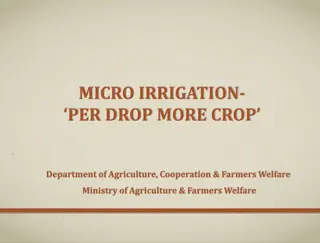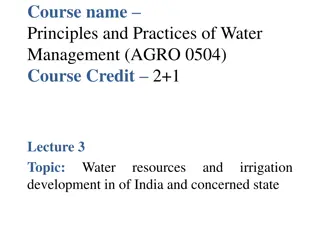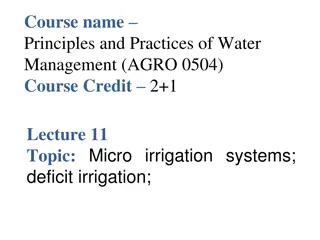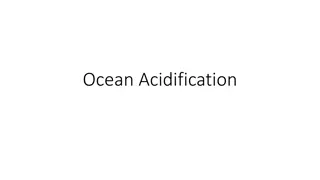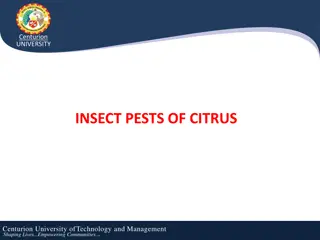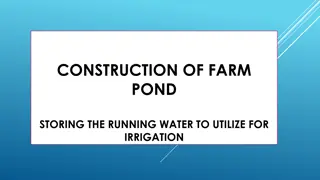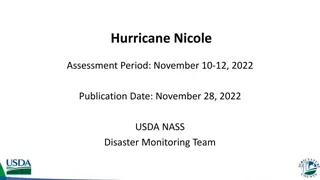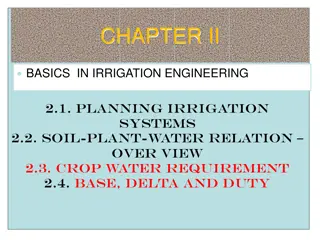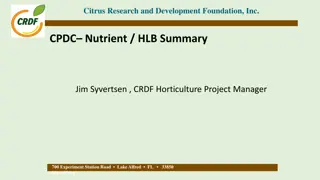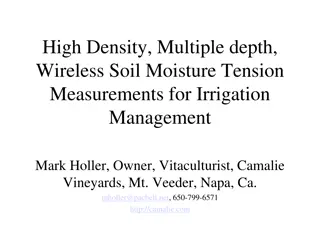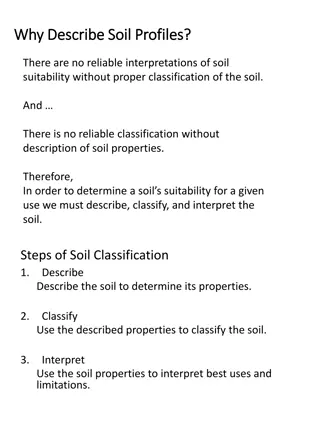Understanding Citrus Nutrient Availability in Relation to Soil pH and Irrigation Water Acidification
This research by Dr. Kelly T. Morgan from the University of Florida explores the impact of soil pH, irrigation water acidification, and nutrient recommendations on citrus trees affected by HLB disease. The study examines the availability of key nutrients such as Mn and Zn, the effects of different spray applications on new growth, and the relationship between leaf nutrient concentrations, tree growth, and yield. Additionally, it delves into the significance of soil alkalinity and its influence on nutrient availability in citrus groves.
Download Presentation

Please find below an Image/Link to download the presentation.
The content on the website is provided AS IS for your information and personal use only. It may not be sold, licensed, or shared on other websites without obtaining consent from the author. Download presentation by click this link. If you encounter any issues during the download, it is possible that the publisher has removed the file from their server.
E N D
Presentation Transcript
Effect of irrigation water acidification and soil pH on citrus nutrient availability Dr. Kelly T. Morgan University of Florida Soil and Water Science Department Southwest Florida Research and Education Center, Immokalee 239 658 3400 conserv@ufl.edu
Nutrient recommendations for HLB affected trees Last Revision to the citrus nutrient recommendations 2008 Currently being reviewed to include information on nutrition of HLB affected trees SP253
Greening Foliar Nutrient Study Duration = 5 years 2010 2015 Commercial Grove Valencia on Swingle 16 X 30 No Spray control Mn, Zn, B at three rates (0.5X, 1.0X, 2.0X)- 1X = IFAS recommendation, applied 3 times per year Annual applications of 1.5x, 3.0x and 6x IFAS recommendations Mn and Zn as sulfates and phosphites Sulfates with and without Potassium nitrate Leaf samples taken prior to (pre) and after sprays (post)
Effect of Sprays on New Growth Leaf Mn and Zn were lower in leaves of trees prior to foliar sprays but increased after spray applications 3.0 and 6.0 times recommendation were most effective Multiples of pre-HLB IFAS recommendation Multiples of pre-HLB IFAS recommendation 0 1.5X 3 X 6X 1.5X 3 X 6X optimum optimum Deficient Deficient 2.5 5 7.5 10 Pounds metal per acre per application x 3 applications per year 7.5 15 22.5 30 Pounds metal per acre per year 0 2.5 5 7.5 10 Pounds metal per acre per application x 3 applications per year 0 7.5 15 22.5 30 Pounds metal per acre per year
Effect of Leaf Nutrient Concentrations on Tree Growth and Yield Multiples of pre-HLB IFAS recommendation 1.5X 3 X 6X Similar trends for both Mn and Zn Similar canopy volume at 3X rate Slight but significantly Greater canopy volume at 6X Increasing yield with increased rate to 3X but lower at 6X
Soil Alkalinity Primarily determined by presence of bicarbonates (HCO3-), Carbonates (CO3-), and hydroxides (OH-) in water. A measure of the capacity of water to neutralize acids. Alkaline compounds in water remove H+ ions and lower the acidity of water (increase pH). Limits nutrient availability in soils
Bicarbonates in Water Water above pH 7.5 is usually associated with high bicarbonates. Recommend levels of 100 ppm or less Forms bicarbonate salts with Ca, Mg, Na, and K. High Ca concentrations will react to form Calcium carbonate or line. Higher calcium carbonate in soils increases pH making many nutrients less available. Particulates can drop out of water and plug emitters or microsprinklers. Soils with excess Ca forms CaCO3 (lime). Treatments: calcium or gypsum (calcium sulfate) to increase calcium availability to plants and soil, elemental sulfur can be used to reduce soil pH, applications of acidified water or acidic fertilizer
Effect of Soil pH on Nutrient Availability Macronutrients (N, K, S, Ca and Mg) highly available between soil pH 6.5 and 8 Micronutrients (Mn, Zn B, and Fe) most available below soil pH 6.5 Best soil pH range for most crops is 6 to 6.5
Plant Uptake Bicarbonate induced chlorosis is caused by transport of bicarbonate into the plant leading to reduced nutrient uptake. Lime-induced chlorosis effects many annual crops and perennial plants growing on calcareous soils. Horneck, D. 2006. Acidifying Soil for Crop Production East of the Cascades. Oregon State
Water Treatment Standard treatment is to lower the water s pH by adding an acid. Lowering the pH to 6.5 or lower neutralizes bicarbonate in the water. Bicarbonates in irrigation water leads to higher soil bicarbonates and pH. Injection of acidified water instead of a dry material to a wide area will reduce bicarbonate accumulation in the irrigated area. Most common acids to inject are sulfuric acid, phosphoric acid.
Acidifying Fertilizers Alternative Acidifying methods Formulations with acidifying materials When ammonium is converted into nitrate in the soil 3H+ are released increasing soil pH Ammonium thiosulfate is also acidifying because it supplies both ammonium and sulfur Replace any filler with slow release forms of sulfur (e.g. Tiger 90) Calcium Nitrate Sodium Nitrate Soda-Potash Potassium Nitrate Ammonium Nitrate Urea Ammonium Sulfate -140 -90 -40 10 lbs of Calcium Carbonate per 100 lbs product
Lower Root Density is related to higher pH Well water pH Soil pH in the wetted zone 1.0 1.0 Fibrous root density (mg/cm3) 0.8 Fibrous root density (mg/cm3) 0.8 0.6 0.6 0.4 0.4 0.2 0.2 0.0 0.0 4.5 5.0 5.5 6.0 6.5 7.0 7.5 3 4 5 6 7 8 9 Soil pH Well water pH J.H. Graham, 2014 - 2016 survey of central Florida citrus groves for effect of bicarbonates
Effect of soil pH on Nutrient status Mature Hamlin/Swingle initial soil pH 7.3 Irrigation water acidified for 3 years Soil pH range from 4 to 7.3 Methods of pH moderation Irrigation water acidification Application of slow release sulfur product Soil and tissue samples, and yield estimation
Effect of Acidificaiton on Water pH 9 Irrigation Water pH Irrigation water within half a pH unit of target 8 No Acid irrigation Water pH 7 6 pH 6.0 pH 5.0 5 pH 4.0 4 3 Jan Jul Jan Jul Jan Jul Jan Jul Jan Sampling Date
Effect of pH on water Bicarbonates 160 Suggested bicarbonate limit = 100 ppm Irrigation Water Bicarbonates Irrigation Water Bicarbonates (ppm) 140 pH 7.3 without S pH 7.3 with S 120 Little reduction in bicarbonates below pH 5 pH 6 without S 100 pH 6 with S pH 5 without S 80 pH 5 with S pH 4 without S pH 4 with S Soil applied S has no effect of irrigation water pH 60 40 Jan Jul Jan Jul Jan Jul Jan Jul Jan Sampling Date
Effect of Irrigaiton Water pH on Soil pH 9 Soil pH Three years to reach target pH 8 No Acid 7 Applied soil S lowered pH by less than half pH unit Soil pH 6 pH 6.0 pH 5.0 5 pH 4.0 4 Jan Jul Jan Jul Jan Jul Jan Jul Jan Sampling Date
Effect of Soil pH on Leaf Calcium 4.0 Leaf calcium increased with lower soil pH Calcium 3.5 Optimum Leaf Nutrient Concentration (%) 3.0 2.5 Calcium increased above optimum level below pH 6.5 Low 2.0 1.5 1.0 0.5 4 5 6 7 8 9 Soil pH
Effect of Soil pH on Leaf Magnesium 1.0 Increased leaf Mg with lower soil pH Magnesium Leaf Nutrient Concentration (%) 0.8 Leaf Mg concentrations above optimum below pH = 6.5 High 0.6 Optimum 0.4 Leaf Mg in high optimum or higher below soil pH = 6 Low 0.2 0.0 4 5 6 7 8 9 Soil pH
Effect of Soil pH on Leaf Manganese 140 Increased leaf Mn with lower soil pH Manganese Leaf Nutrient Concentration (mg kg-1) High 120 Leaf Mn concentration s above optimum below pH = 7 100 80 60 Optimum Leaf Mg in high optimum or higher below soil pH = 6 40 20 Low 0 4 5 6 7 8 9 Soil pH
Effect of Soil pH on Leaf Zinc 140 Increased leaf Zn with lower soil pH Zinc 120 Leaf Nutrient Concentration (mg kg-1) High 100 Leaf Zn concentrati ons above optimum below pH = 7 80 Optimum 60 40 Leaf Mg in high optimum or higher below soil pH = 5.5 20 Low 0 4 5 6 7 8 9 Soil pH
Effect of soil pH on Yield Yield per tree increases with average yearly soil pH. Yield Per Tree Yield (boxes Per Tree) 3 No significant increase in yield below soil pH of 6.0 Recommendat ion monitor soil pH and adjust to 6.0 6.5 as needed 2.5 2 1.5 1 4 4.5 5 5.5 6 6.5 7 7.5 8 Average yearly soil pH
Conclusions Soil pH affects crop plants ability to extract nutrients, including N, P, K, Mg, Ca, Mn, Zn Higher soil pH reduce plant nutrient uptake by reducing soil water nutrient solubility, Water and soil bicarbonates should be addressed to allow for proper nutrient uptake, Irrigation water acidification or application of acidifying fertilizer materials should be used to reduce soil pH in the irrigated area, Yield improves to soil pH of 6.0, maintain soil pH between 6.0 and 6.5


